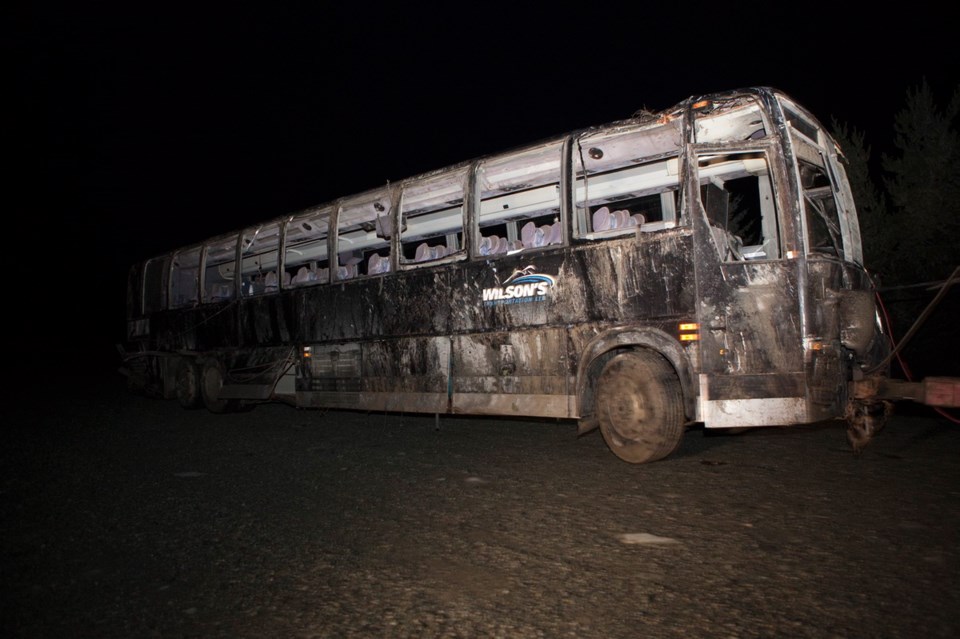A narrow section in a Bamfield logging road, an oncoming vehicle and unused seatbelts proved a deadly combination when a bus plunged down an embankment, killing two University of Victoria students in September, according to an RCMP report.
“If this happened anywhere else on the 60-plus kilometres, there would have been no issue,” RCMP Sgt. Brian Nightingale, a senior forensic collision reconstructionist, said in an interview.
An RCMP technical report based on data from the bus’s electronic control module and physical evidence from the crash site has been submitted to the B.C. Coroners Service and Transport Canada and shared with the Times Colonist.
Emma MacIntosh Machado, 18, of Winnipeg, and John Geerdes, 18, from Iowa City, Iowa, died in the crash.
The report, just one part of the RCMP’s investigation into the crash, does not find fault, but reports on the bus’s speed, road conditions and how the two students likely died.
The crash occurred on Sept. 13, when a Wilson’s Transportation coach carrying 45 first-year University of Victoria students and two teaching assistants en route to Bamfield Marine Sciences Centre left Bamfield Main, a gravel logging road that links Port Alberni and Bamfield.
Electronic crash data revealed the 2001 Prevost XL2 bus crashed at 7:55 p.m. It was 44.3 kilometres from Bamfield Marine Sciences Centre.
The bus had been travelling an average speed of no more than 37 kilometres per hour up a small grade about 50 seconds before the crash. “The speed of the bus was not a contributing factor,” said Nightingale, unit commander of the Vancouver Island Collision Analysis and Reconstruction Service.
Data show the bus was decelerating uphill when it rounded a slight right-hand bend. The lights of an Jeep, coming down the hill, became visible about 50 to 75 metres ahead.
“When [the Jeep] comes around the bend, he’s up higher, so his headlights are probably shining right into the driver’s eyes,” said Nightingale.
The bus was 2.8 metres from the road’s edge, but at a point where the road begins to narrow to 9.2 metres from 10.8 metres.
Bamfield Main is wide enough for two-way traffic, said Nightingale, but the left wheels of the 2.6-metre-wide bus were on what would have been the centre line. “For him, it would be too close for a vehicle approaching in the opposite direction,” said Nightingale.
He estimated the bus pulled about 50 centimetres to the right.
“It’s not really a significant steer to the right,” he said. “It’s just the fact that it narrows by 1.6 metres right at the same time when the bus starts to move over to the … road edge. It’s that combination of the two.
“If the road didn’t narrow at that location, there would not have been a crash.”
When the driver pulled to the right, the bus’s right-side wheels jumped over a gravel “curb,” called sloughing, onto a soft shoulder at the top of an embankment. The bus continued in the soft shoulder for about 16.8 metres at 7.2 km/h, sinking to the right.
After 14 metres, the bus started to tip, then rolled onto its right side, sending unbelted students on the left on top of those seated on the right. Then the bus rolled onto its roof.
MacIntosh-Machado and Geerdes were thrown out the window and pinned, said Nightingale.
Trees prevented the bus from sliding farther down the muddy embankment. The upturned wheels were about three metres from the road edge.
There was no cell reception at the scene. More than an hour after the crash, police received a distress call from a satellite device registered to the University of Victoria in a remote location between Port Alberni and Bamfield.
A police file was opened at 9:17 p.m. Nightingale, who has probed commercial vehicle collisions and fatal crashes for more than 25 years, arrived at 12:53 a.m. the next day.
Transport Canada said the bus had seatbelts installed after it was purchased, said Nightingale. If a bus is manufactured with seatbelts, the occupants must wear them, he said, but if they are added later, it’s not mandatory.
“Had they been worn, the fatal injuries would likely not have occurred,” said Nightingale, “and the injuries would have considerably reduced.” Several people were hurt when they were tossed around inside the bus as it slid off the road.
Wilson’s Transportation has declined to comment. Wilson’s and the University of Victoria both say they are investigating the crash and awaiting the results of other investigations.
Emma MacIntosh-Machado’s mother, Ethel MacIntosh, said she still has questions for the university — including the departure time, the mode of transportation, the risk-management plan, road conditions, and who was supervising the trip and making decisions.
“Obviously, we feel that mistakes occurred and this should not have happened,” said MacIntosh. “You don’t send your child off to university to pick up their ashes in a Tupperware container two weeks later.”
MacIntosh said she’s not optimistic anyone will ever be found responsible for the bus tragedy.
“Emma and John did not have to die like this and our families will never be the same,” said MacIntosh. “I feel it was just a calamity of errors, one thing after another.
“There isn’t any one specific thing that went wrong but there were certainly multiple things.”
Mary Murphy, mother of Geerdes, who she described as capable, athletic and strong, said the family is devastated and heartbroken by his death.
“People loved John and they loved Emma, too.
“They were two vibrant young kids who deserved a better outcome.”



